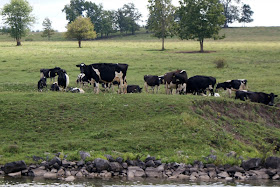Fort Edward Yacht Basin
We went through another four locks today. We only have six more locks in the Champlain Canal and the Federal Lock at Troy, and then we will be back to open water. Once we pass the Troy lock we'll have to start looking at the tides and current again...there's always something trying to slow us down. Two more travel days and we'll be back in Waterford, where we started the Erie Canal. From there we'll start back tracking through familiar waters south.
We're docked in Fort Edwards tonight. The town provides a great place to tie up with free water and electricity. It's in a little park right in the heart of town. Fort Edwards was established in 1859 and a lot of the old homes are still in beautiful shape. We rode our bikes along Old Champlain Canal Towpath to the Glens Falls Feeder Canal. It was interesting to see the old locks; they were just like the locks we've been in, just smaller. The Glens Falls Feeder Canal is a canal from Glens Falls, New York, through Hudson Falls and into Fort Edward. It's seven miles long and delivers water from above Glen's Falls on the Hudson River to the highest point of the Champlain Canal. The first Feeder Canal was constructed around 1822. In 1832, the Feeder Canal was widened and deepened to accommodate boat traffic as well. The locks were 15 feet wide and 100 feet long; these dimensions controlled the size of canal boats in the Champlain Canal system while the locks were in use. The present-day Champlain Barge Canal eliminated the need for boat traffic on the Feeder Canal in the early 1900s. Today the canal is still an important source of water for the Champlain Canal. When all these canals were opened, mules and horses pulled the barges through, so the canals were just wide enough for one barge. Turning basins were created in certain areas so barges could pass.
Coming through the locks today made me start thinking of all the locks we've done this summer and how different all the canals were. We've come through six canal systems and four stand alone locks. Their size changed drastically and each canal system had a little different way to tie up as you locked through. Park Canada's locks were the oldest locks we were in, but seemed the cleanest. I think it only seemed that way since you use your own lines to place around cables...no need to grab an old slimy line that has been hanging in the water all season. The locks on the Ottawa River were the easiest, because we were tied off to a floating dock, we didn't have to hold onto any lines at all. Generally we didn't have any trouble in the locks, our boat's size and layout of the deck made it easy to hold it in place once we were in the lock...of course the captain did a wonderful job maneuvering the boat into place. The locks have been fun, but we're both looking forward to being through with them.
Lock Statistics:
Troy Federal Lock (1 lock) 45’ x 520’ (We’ll go through this one twice)
Erie Canal (22 locks) 45’ x 328’
Oswego Canal (7 locks) 45’ x 328’
Rideau Canal Locks (48 locks) 33’ x 134’
Carillon Lock (1 lock) 33’ x 134’ our largest lift @ 65’
St. Anne de Bellevue Lock (1 lock) 40’ x 180’
St. Lawrence Seaway Locks (2 locks) 80’ x 766’
St. Ours Lock (1 lock) 39’ x 325”
Chambly Canal Locks (9 locks) 23’ x 120’
Champlain Canal Locks (11 locks) 45’ x 328’
Champlain Canal Lock 11
We're getting into flatter country...a lot more farms todayHappy cows of New York
Not everything we see is beautiful! This is located right after lock 7.
Lock one on the feeder canal - it looks smaller than 15' to me
The five combined locks on the old feeder canal







No comments:
Post a Comment